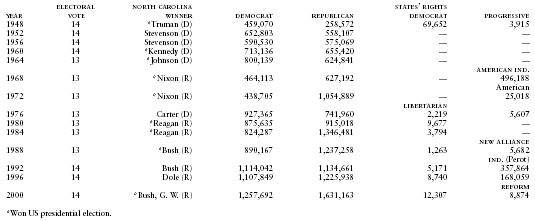North Carolina
Local government
As of 2002, North Carolina had 100 counties, 541 municipalities, and 175 special districts. That year the state has 319 public school systems.
Counties have been the basis of local government in North Carolina for more than 300 years, and are still the primary governmental units for most citizens. All counties are led by boards of commissioners; commissioners serve either two- or four-year terms, and most are elected at large rather than by district. Most boards elect their own chairman from among their members, but voters in some counties choose a chairman separately. More than half the counties employ a county manager to supervise day-to-day operations of county government. Other

North Carolina Presidential Vote by Political Parties, 1948–2000
| YEAR | ELECTORAL VOTE | NORTH CAROLINA WINNER | DEMOCRAT | REPUBLICAN | STATES' RIGHTS DEMOCRAT | PROGRESSIVE |
| *Won US presidential election. | ||||||
| 1948 | 14 | *Truman (D) | 459,070 | 258,572 | 69,652 | 3,915 |
| 1952 | 14 | Stevenson (D) | 652,803 | 558,107 | — | — |
| 1956 | 14 | Stevenson (D) | 590,530 | 575,069 | — | — |
| 1960 | 14 | *Kennedy (D) | 713,136 | 655,420 | — | — |
| 1964 | 13 | *Johnson (D) | 800,139 | 624,841 | — | — |
| AMERICAN IND. | ||||||
| 1968 | 13 | *Nixon (R) | 464,113 | 627,192 | — | 496,188 |
| AMERICAN | ||||||
| 1972 | 13 | *Nixon (R) | 438,705 | 1,054,889 | — | 25,018 |
| LIBERTARIAN | ||||||
| 1976 | 13 | Carter (D) | 927,365 | 741,960 | 2,219 | 5,607 |
| 1980 | 13 | *Reagan (R) | 875,635 | 915,018 | 9,677 | — |
| 1984 | 13 | *Reagan (R) | 824,287 | 1,346,481 | 3,794 | — |
| NEW ALLIANCE | ||||||
| 1988 | 13 | *Bush (R) | 890,167 | 1,237,258 | 1,263 | 5,682 |
| IND. (Perot) | ||||||
| 1992 | 14 | Bush (R) | 1,114,042 | 1,134,661 | 5,171 | 357,864 |
| 1996 | 14 | Dole (R) | 1,107,849 | 1,225,938 | 8,740 | 168,059 |
| REFORM | ||||||
| 2000 | 14 | *Bush, G. W. (R) | 1,257,692 | 1,631,163 | 12,307 | 8,874 |
elected officials are the sheriff, register of deeds, and the school board. Counties are subdivided into townships, but these are for administrative convenience only; they do not exercise any independent government functions.
County and municipal governments share many functions, but the precise allocation of authority varies in each case. Although the city of Charlotte and Mecklenburg County share a common school system, most often schools, streets, sewers, garbage collection, police and fire protection, and other services are handled separately. Most cities use the council-manager form of government, with council members elected from the city at large. Proliferation of suburban governments was hampered by a 1972 constitutional amendment that forbids the incorporation of a new town or city within 1 mi (1.6 km) of a city of 5,000–9,999 people, within 3 mi (4.8 km) of a city of 10,000–24,999, within 4 mi (6.4 km) of a city of 25,000–49,999, and within 5 mi (8 km) of a city of 50,000 or more unless the general assembly acts to do so by a three-fifths vote of all members of each house.